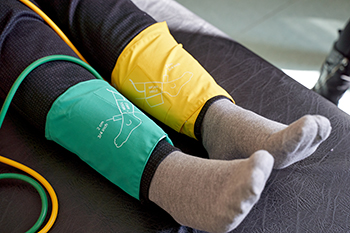
Peripheral artery disease, or PAD, predominantly affects the arteries supplying blood to the legs and feet, leading to various symptoms and complications related to these areas. Symptoms include painful leg muscle cramping during physical activities, particularly walking or climbing stairs, and is sometimes referred to as intermittent claudication. Other signs encompass coldness in the lower legs or feet, skin color changes, leg pain at rest, hair loss, dry and pale skin, bluish feet, brittle toenails, numbness, muscle wasting, and non-healing leg ulcers. PAD is primarily caused by fatty deposits accumulating in the arteries, known as atherosclerosis, with contributing factors including smoking, diabetes, high-fat diet, elevated cholesterol, high blood pressure, and advancing age. Seeking podiatric attention for leg pain is essential, and urgent consultation is warranted for severe symptoms, such as sudden foot pain, numbness, or bluish toes. Diagnosis involves medical evaluation, pulse checks, and various tests. Management includes lifestyle changes, medications, and, in severe cases, surgery. If you know you have peripheral artery disease or have symptoms as described above, it is suggested that you make an appointment with a chiropodist for a diagnosis and treatment for your specific situation.
Peripheral artery disease (PAD) is a condition that causes poor circulation in the lower limbs. If you have PAD, please consult with one of the chiropodists from Complete Family Footcare & Therapy. Our clinicians can help you maintain the health of your lower limbs and your mobility.
What is peripheral artery disease?
Peripheral artery disease is characterized by reduced blood flow to the lower limbs. This occurs due to a buildup of a fatty substance called plaque in the arteries. The plaque causes the arteries to become narrow and harden, which makes it difficult for blood to get to the lower limbs. Without adequate blood flow, the tissues of the legs, ankles, and feet do not get enough oxygen and nutrients to function properly, which can lead to various symptoms as the condition progresses. Having poor circulation also increases your risk of cardiovascular events, such as heart attacks and strokes.
Symptoms
In its initial stages, PAD is often asymptomatic. If symptoms do arise, they often include:
Muscle cramps
Weakness
Fatigue
Pain that gets worse with physical activity
Balance problems
Difficulty walking
Diagnosis
PAD can be diagnosed through a thorough physical examination, medical history, and vascular testing. There are many simple, non-invasive tests that your chiropodist can use to determine your risk of having PAD. These include the ankle-brachial index (ABI) test and Doppler ultrasounds.
Treatment
Treatments for PAD focus on lifestyle changes and medication management to lessen symptoms and prevent heart attacks and strokes. Your chiropodist may suggest various foot and ankle exercises to increase the strength and flexibility of your feet and ankles, boost circulation, and improve mobility. They may also suggest routine visits to monitor and maintain the health of your feet since poor circulation can lead to a variety of foot and ankle complications.
If you have any questions, please feel free to contact our offices located in . We offer the newest diagnostic and treatment technologies for all your foot care needs.
